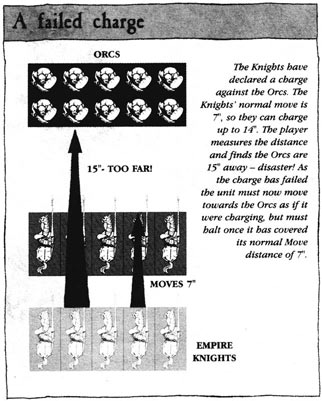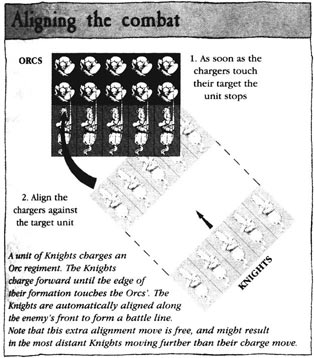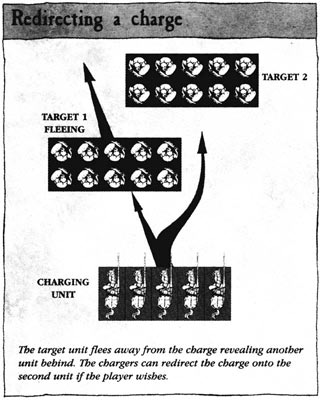Chargers are moved after compulsory movement and before you move the rest of your army. Make sure you complete all charges before moving other troops. Chargers move at double their normal Move rate, but must make the usual deductions for crossing terrain and obstacles. For example, mounted Knights have Move 7 and so can charge up to 14". If moving over difficult terrain, such as a muddy field, they move at half their speed, reducing their charge distance to 7". 
Before you move a charging unit check that your opponent has declared his response and that troops electing to flee have been moved and troops electing to stand & shoot have done so. Measure the distance between the chargers and their target. If the enemy has fled, or if you have estimated your charge incorrectly, your troops might not be able to move far enough to reach their intended target. If this is the case, the charge has failed. If a charge fails, the unit is moved at its normal Move rate rather than double speed. The unit is moved directly towards the intended target as if it were charging but halts once it has covered its normal Move distance. This represents when troops have begun to charge before realising it is impossible to reach their enemy; consequently their movement peters out as they lose impetus and enthusiasm. A unit that fails its charge cannot shoot with missile weapons that turn, though Wizards may cast spells. A charging unit cannot turn or change formation. This is because the troops are running or galloping once the charge has begun and are unable to execute delicate manoeuvres even if they were able to hear the orders of their leaders above the din. The following rules govern manoeuvres during a charge:
If chargers need to wheel towards their target, execute the wheel as already described, measuring the distance wheeled as you normally would. This distance counts as part of the total distance charged. For example, if a unit can charge 12" it might wheel 4" to bring models to face the enemy and then move up to 8" towards them. 
Once a unit has completed any required wheel it is moved straight forward towards the enemy and stops as soon as the two units touch. Once the charging unit is in contact it is automatically aligned against its enemy as shown in the diagram below to form a battle line. This extra alignment move is free. If it is impractical to align a unit properly because of interposing terrain, other models, or whatever, then it is acceptable to re-align the charged unit as well (or instead) so that the battlelines remain neat. A confusing situation may arise when interposing terrain or models make it impossible to align the whole unit, for example. Rather than clutter the rules with endless clarifications, we have included further examples in the back of this book. Once opposing units are engaged in close combat they may not move away until one side or the other breaks or is destroyed. Units already engaged in close combat at the start of their turn cannot move but must continue to fight in the Close Combat phase. If a charged unit stands & shoots, it is possible that it - may cause sufficient casualties on the charging unit to ;force an immediate Panic test. Panic tests and other special psychological tests are explained in the Psychology section. This might result in a charge being brought to a halt before contact is made with the enemy. That is why it is important to work out fire from enemies who stand & shoot before moving chargers. If the chargers are out of missile range at the beginning of their charge then work out missile casualties at the maximum range of the weapon. If a charged unit flees as it is charged then it will move directly away from its chargers either 2D6" or 3D6" depending on whether its Movement rate is up to 6" or more than 6", as explained later. It may be that fleeing troops move too far for the chargers to catch them, in which case the chargers move their normal Move rate exactly as for any other failed charge. If fleeing troops do not move far enough away to avoid their attackers then they are in deep trouble! If the chargers have sufficient movement to catch them then the entire fleeing unit is destroyed. The chargers only need to catch one model to destroy the whole unit as it flees. Chargers move their full charge move, moving past the point where the enemy was caught if necessary. The fleeing troops are run into the ground or scattered beyond any hope of recovery. See the rules for fleeing troops in the Close Combat section for more details.  Redirecting
A Charge Redirecting
A ChargeIf a charged unit flees, it can happen that another enemy unit is now within the charging unit's reach. If this fresh enemy unit is within range then the player is allowed to redirect the charge, though he does not have to. He must declare that his unit is charging against the new target, and the target must make a response as normal. If this unit flees as well then the charging player is not allowed to redirect his charge again. If there is a choice of units that can be charged, the charging unit must go after an enemy that is nearest to the original target unit. A charge can sometimes trigger extra movement from the enemy. For example, Goblin Fanatics will leap out of their units as soon as enemy approach within 8". This happens out of the normal sequence: the charge is halted as soon as the chargers move within 8" and the Goblin Fanatics are moved and any damage they cause is worked out straight away. It is up to the player to say that he has out of sequence movements or actions to perform at the appropriate moment. |